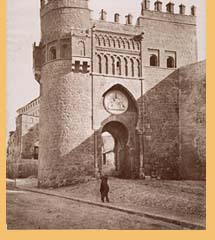 |
Jean
(Juan) Laurent
Ávila.- 57.- Portada
de la
Catedral |
| |
 |
Jean
(Juan)
Laurent y Cía.
Toledo.- 567.- Claustro de San
Juan de los Reyes, visto desde
el
fondo
|
| |
 |
Jean
(Juan)
Laurent y Cía.
Ronda (Málaga).- 2111 .- La
Gruta del Gato |
| | |
Albumen prints such as these were
common in the late nineteenth century, and are distinctive for an
egg white binder, similar to an emulsion. The warm color of these
sharp, detail-rich images was obtained after gold toning, a process
that also helped preserve them. Negatives were usually
contact-printed using sunlight and specially prepared paper.
Like
most of his contemporaries, Jean Laurent exposed collodion glass
plate negatives. Collodion is made from inflammable chemicals such
as guncotton and ether. Wet collodion glass plates had to be coated,
exposed, and developed within a short period of time, so most
photographers traveled with portable darkrooms. Dry processes,
invented subsequently, allowed exposed plates to be developed at a
later time. The low sensitivity to light characteristic of early
processes explains why subjects in motion, such as trees blowing in
the wind, often appear blurred.
Laurent was an entrepreneur who
employed other photographers-notably native Spaniard Jose
Martinez-Sanchez-whose contributions helped make possible the
production of the over 11,000 negatives attributed to the J. Laurent
Studio. Together, Laurent and Martinez-Sanchez invented leptographic
paper, a thin collodion photographic printing paper that enhanced
both the quality and preservation of photographs. Although other
established studios and photographers used it, the paper
was not
a commercial success.
J. Laurent died in the late 1880s or early
1890s. His stepdaughter continued to sell his prints, as did many
other later J. Laurent Studio proprietors. Exquisite examples of
vintage prints can be found in various collections around the world.
Their negatives reside, under the name of the last owner of the
material-Ruiz Vernacci-in Madrid's Instituto del Patrimonio
Historico Español, and are now the property of the people of
Spain. |



